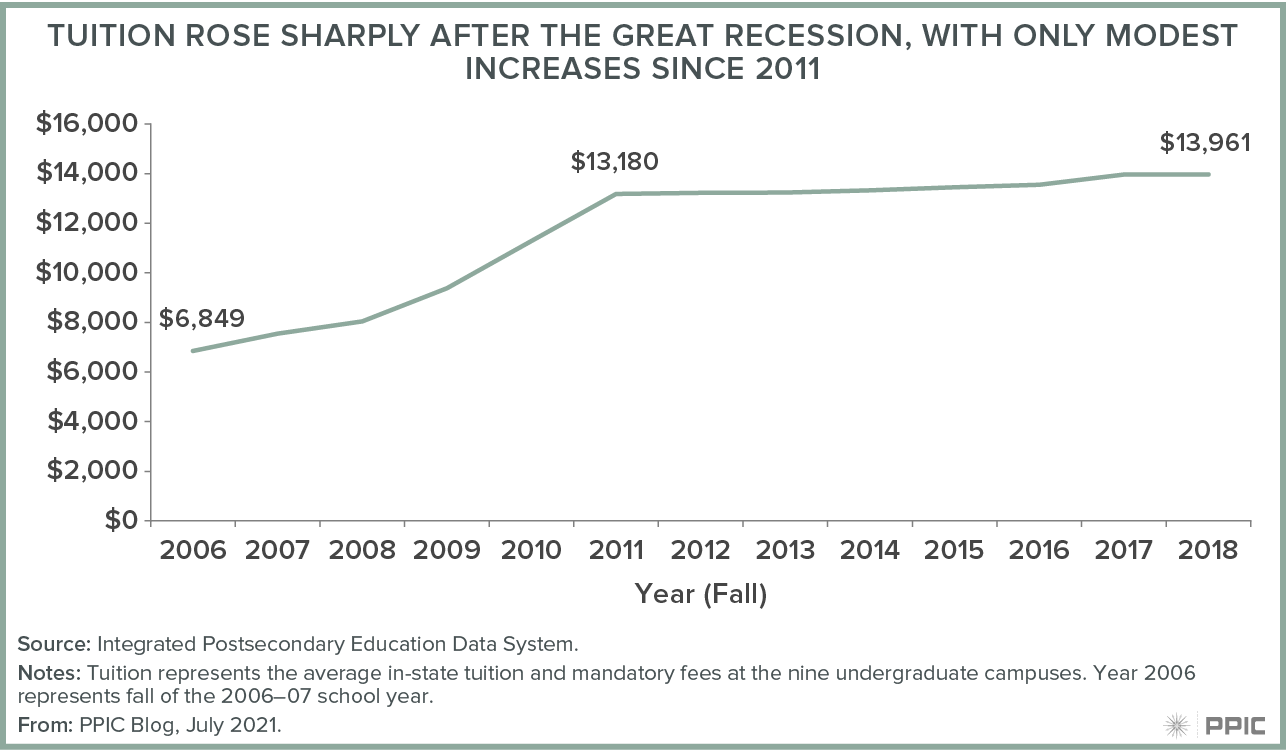This week, the University of California (UC) Regents are considering a new plan to combat sharp spikes in tuition and improve the predictability of tuition costs. Regular, planned tuition increases could help students prepare for the future and ensure the growth of an important revenue source for UC. But they could also affect affordability for some—including those who may be eligible for financial aid but don’t apply for it. If the plan is enacted, continued outreach to students about the importance of applying for financial aid will be key.
The core funding for UC undergraduate education comes from two main sources—state support and tuition. Historically, tuition increases have followed recessions, as universities use revenue from tuition increases to make up for state funding shortfalls. For example, after the Great Recession caused widespread state budgetary cuts, UC increased tuition from about $6,850 in 2006 to $13,180 by 2011.

Unpredictable, sharp increases in tuition can be a challenge for current and incoming students. For example, students starting college in 2006 saw their yearly tuition jump from about $6,850 in their first year to nearly $9,400 in their fourth year (a 42% increase). From 2006 to 2011, prospective students saw tuition rise between 7% and 20% each year, providing a moving target for those trying to save for college.
Due to the combination of state disinvestment and tuition increases, tuition has become a more important source of revenue for UC. Tuition has not kept pace with inflation since 2011, and the proposal to schedule yearly tuition increases in advance would keep this important source of revenue growing in line with the rising costs the university faces.
The proposed plan would guarantee that tuition does not increase for six years once a student starts at UC. However, each successive freshmen cohort would see planned tuition increases about on par with inflation, but at no more than 6% a year. The new policy would likely stabilize costs for those in college, even if there is another recession. Students entering college in a few years also benefit from some predictability, as they can estimate what tuition might be when they start at UC.
Who would shoulder the burden of higher tuition? As PPIC research has shown, students from families with lower incomes were generally insulated from tuition increases due to state grant aid matching tuition and institutional aid from UC. As a result of available financial aid, over half of UC students pay no tuition, and that won’t change with the planned tuition increases. Moreover, some of the revenue generated by tuition increases will go to grants to help pay for non-tuition college costs—like living expenses—for students from lower-income families.
However, the new tuition policy will likely raise costs for students from higher-earning families, as well as those who are not eligible for state aid—such as nonresident students—and those who do not apply for aid, even if they would have been eligible. The state would also see higher costs, as financial aid would increase to match tuition levels.
Regardless of whether the UC Regents choose to enact this policy, it will continue to be important for the state and UC to reach out to students and families about the availability of state, federal, and local financial aid grants and the importance of applying for federal and state aid. Without that information, students who would qualify for aid may end up leaving money for their education on the table, or they may not apply to UC at all due to concerns about affordability.






